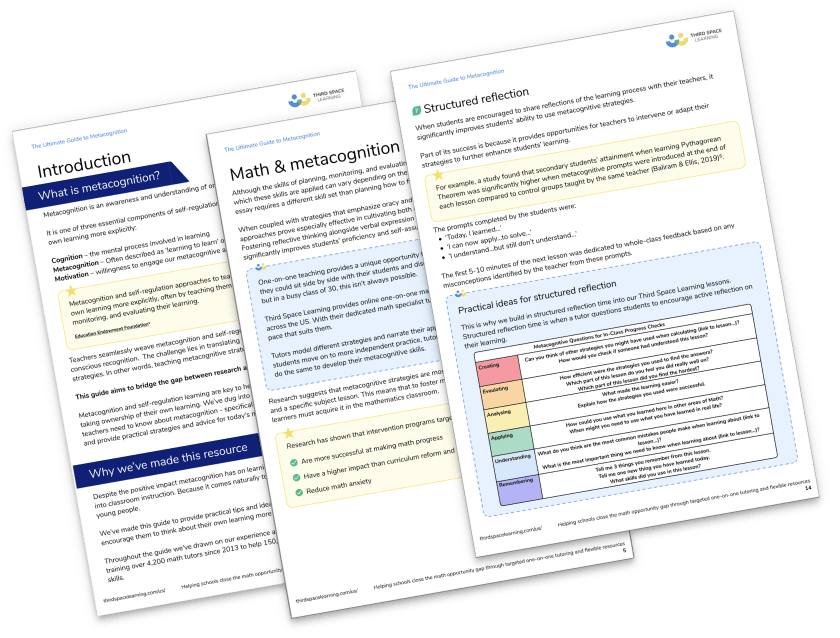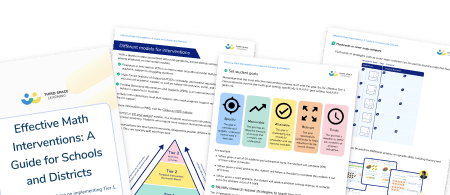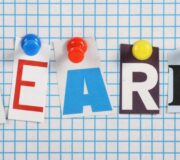5 Effective Instructional Strategies Educators Can Use In Every Classroom
Instructional strategies help to engage students in learning. The instructional strategies teachers choose drive the learning experience students have and how they engage with knowledge, facts, and critical thinking.
This article provides an overview of what instructional strategies are, how they impact students’ learning experiences as well as different types and examples of instructional strategies to use in every classroom.
What are instructional strategies?
Instructional strategies are the techniques teachers use to deliver lessons. Effective instructional strategies encourage students to participate actively in the learning process. They can also improve classroom management through active student participation.
When implemented effectively, instructional strategies support all students reach the lesson’s learning objectives, regardless of grade level, subject, and learning profile, including students with learning differences.
Teachers should use instructional strategies that fit the developmental levels and needs of their students and the goals for the lesson. For example, when students are introduced to a new topic, a teacher may use whole class, direct instruction to teach new material. But, as students gain confidence with the content, the teacher may have students engage in group work or cooperative learning. When assessing what students have learned, a teacher may use a formative exit ticket to understand what each student learned.
The difference between instructional strategies and teaching strategies
The terms instructional strategies and teaching strategies are often used interchangeably.
In this article, instructional strategies include the overarching methods that teachers use to facilitate effective teaching and learning.
Whereas teaching strategies are the specific approaches teachers use to engage students and communicate information.
For example, an instructional strategy may be direct instruction, and the teaching strategy that a teacher uses within direct instruction is call and response.
Effective Math Interventions: A Guide for Schools And Districts
A guide for school leaders, administrators, math specialists and interventionists on implementing successful math interventions for students in need of extra support.
Download Free Now!Vary your instructional strategies
Including a variety of instructional strategies in one lesson provides differentiation for students as they master skills. It also helps ensure teachers support all students’ preferred learning strategies.
When planning instructional strategies for each lesson, consider including the following instructional strategies:
- Question and assess students’ prior knowledge so that students are not reviewing material they already know;
- Direct instruction with opportunities for high levels of student engagement;
- Activities that provide relatable real-world problems for students;
- Opportunities for students to demonstrate that they have mastered a concept;
- Support for students with additional learning needs who may require extra direct instruction or accommodations.

Meet Skye, the voice-based AI tutor making math success possible for every student.
Built by teachers and math experts, Skye uses the same pedagogy, curriculum and lesson structure as our traditional tutoring.
But, with more flexibility and a low cost, schools can scale online math tutoring to support every student who needs it.
Find out moreKey components of every effective instructional strategy
When considering lesson plans, teachers must decide on the most effective instructional strategies to help students reach the learning goal or desired learning outcome.
During the lesson planning process, teachers must consider:
- Students’ needs and learning styles;
- How students engage in learning;
- Learning experiences to support students’ learning;
- Metacognition and application of skills;
- How they will support student mastery through feedback.
Teachers must also think about how they can set up the learning environment to engage students through the instructional strategies they use. A classroom that relies on direct instruction should have more space for whole group instruction. But, a project based learning classroom should have more space for small group work.
Additionally, teachers need to align learning materials with the instructional strategies. Fore example, a teacher may use a graphic organizer to help students structure their learning during an interactive jigsaw activity.
Finally, instructional strategies must also align with summative and formative assessments. For example, rubrics are wonderful for assessing a student’s research project or presentation, but not for assessing a student’s memorization of math facts.
Student needs
In any class, no group of students have the same knowledge, skills, and needs. Therefore, instructional strategies should address each student’s needs.
For example, a class masters adding and subtracting fractions. Instead of continuing with direct instruction, the teacher uses an interactive instruction approach to engage learners in a project that requires them to apply operations with fractions.
But, if the class do not know how to add and subtract fractions, the teacher may use direct instruction first so students can solidify their knowledge before engaging in any problem solving.
When planning an instructional approach, teachers should consider:
- Students’ background knowledge;
- Students’ current skill level;
- Student’s learning styles, learning strategies and preferences;
- The lesson objective;
- How far do students need to progress to meet the objective?
Engagement
While student engagement should be high during any lesson, differentiated instruction using different instructional strategies engages students in different ways, keeping engagement higher.
During direct instruction, the teacher is in control of the presentation and learning; students look to the teacher for direction. On the other hand, in indirect instruction, students are engaged in learning activities that require them to control their own learning. Students look to the teacher for support, and the teacher asks more questions to drive learning instead of telling students what they need to know.
For example, in a direct instruction lesson about fractions, the teacher will explain what a fraction is, provide examples, and use effective questioning to lead students through examples.
Whereas, in an indirect lesson about fractions, the teacher may put out manipulatives that represent fractions and circulate as students work with the manipulatives, asking questions about what students notice about each fraction.
While the objective for each lesson is the same, the instructional strategies differ.
Critical thinking
Whatever instructional strategy a teacher uses, it should move students through foundational concepts into critical thinking.
Sometimes, students need to learn a lot of information in a shorter amount of time, so direct instruction is the most efficient method. Other times, students will learn more critical thinking through inquiry-based learning approaches.
The instructional strategy that the teacher chooses should align with outcomes for students’ higher order thinking.
Real-life application
All instructional strategies should connect what students learn in school to real-life applications. This makes learning meaningful for students and helps them connect their experiences to new information. Teachers must consider students’ prior knowledge as well as the end goal when planning instructional strategies for real-life application.
When learning about area and perimeter, the teacher may assign students the real-world task of designing a garden. Students must apply their area and perimeter knowledge to connect this math skill with their experience of gardens.
The goal is that students engage in authentic learning experiences and apply math skills while practicing foundational skills.
Feedback
Regardless of the instructional strategy, students need feedback on their performance in order to learn and progress. They need to know what they are doing well, and how they can improve.
The type of feedback may differ based on the instructional strategy, but all feedback should be constructive and timely-given for the student to correct the error or misconception.
| Instructional Strategy | Example of Feedback |
| Direct instruction If a student answers incorrectly, the teacher prompts the student with the correct response and has the student repeat it. | A student solves 5×7 and responds with 30, the teacher prompts the student with the correct response, 35, and asks the student to repeat the correct answer. |
| Indirect instruction The teacher points out a student’s mistake and asks them to review it independently or with their group. | Students complete a multi-step word problem requiring addition and division. The teacher notices that the student has added, but subtracted instead of divided so they put a star by the error and tell the student to turn to a peer who completed the problem correctly and see if they can work out where they went wrong. |
| Interactive instruction During part of the lesson, such as turn-and-talk, the teacher pauses students and prompts them by asking a question | The teacher writes a division math problem on the board. While students are working, the teacher circulates and notices one group that is organizing the division in an unconventional, but accurate way. After a while, the teacher has the group share how they approached the problem. |
| Experiential instruction The teacher engages with a student during an activity and asks them what skill they are applying and how they know it is the right one. | Students apply their area and perimeter knowledge to create a playground map. While students work, the teacher circulates and asks students which equation they are applying to calculate area and perimeter. |
| Independent instruction Each student receives individual, specific written feedback. | The teacher assigns an online quiz with problems from the day’s lesson. They review students’ responses and comment on the process that each student used. |
5 types of effective instructional strategies
There are many types of instructional strategies, and learning activities that support each. Effective instructional strategies include:
- Direct instruction
- Indirect instruction
- Interactive instruction
- Experiential learning
- Independent study
1. Direct instruction
Direct instruction is a common teaching strategy used to present information in a clear, systematic manner. It helps students learn efficiently, increase retention, and use what they learn to solve problems and think critically.
The teacher delivers direct instruction while students follow the teacher’s instructions. Despite seeming so, it is not passive. Students should actively engage in direct instruction lessons and the teacher should constantly track student understanding, provide feedback, and move students towards mastery.
When appropriate, Third Space Learning’s AI tutor provides direct instruction to help students understand new concepts or address misconceptions. Instruction is clear and systematic and offers many opportunities for student participation through one-on-one math talk.
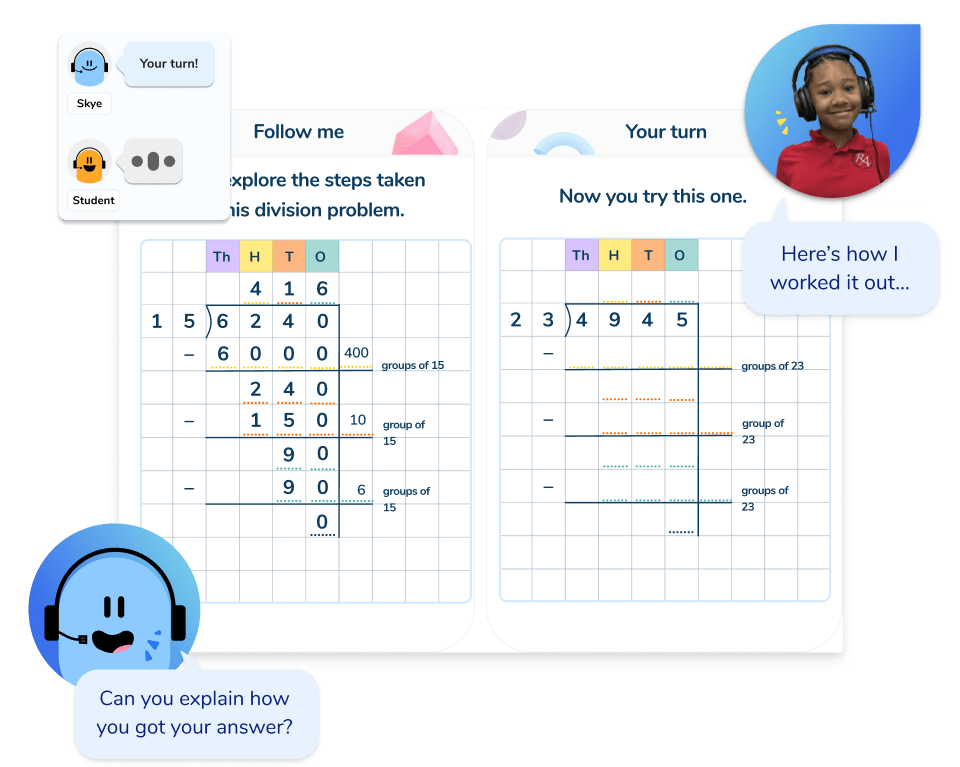
Questioning
Teachers use questioning in direct instruction to elicit a response from students. Students listen to the information, and teachers then use effective questioning to ensure students understand the information.
For example, students learn about the angles of a triangle. Then, the teacher asks questions about angles while students write the responses on mini-whiteboards and hold them up. This helps the teacher monitor which students are mastering the material.
Highly-trained math tutors use effective questioning in all one-on-one math tutoring sessions to ensure students understand the concepts taught and misconceptions covered. Qualified teachers train and program Skye to use questioning effectively to accelerate student learning. Each expertly designed one-on-one math lesson is complete with questions and sentence stems for Skye to use.
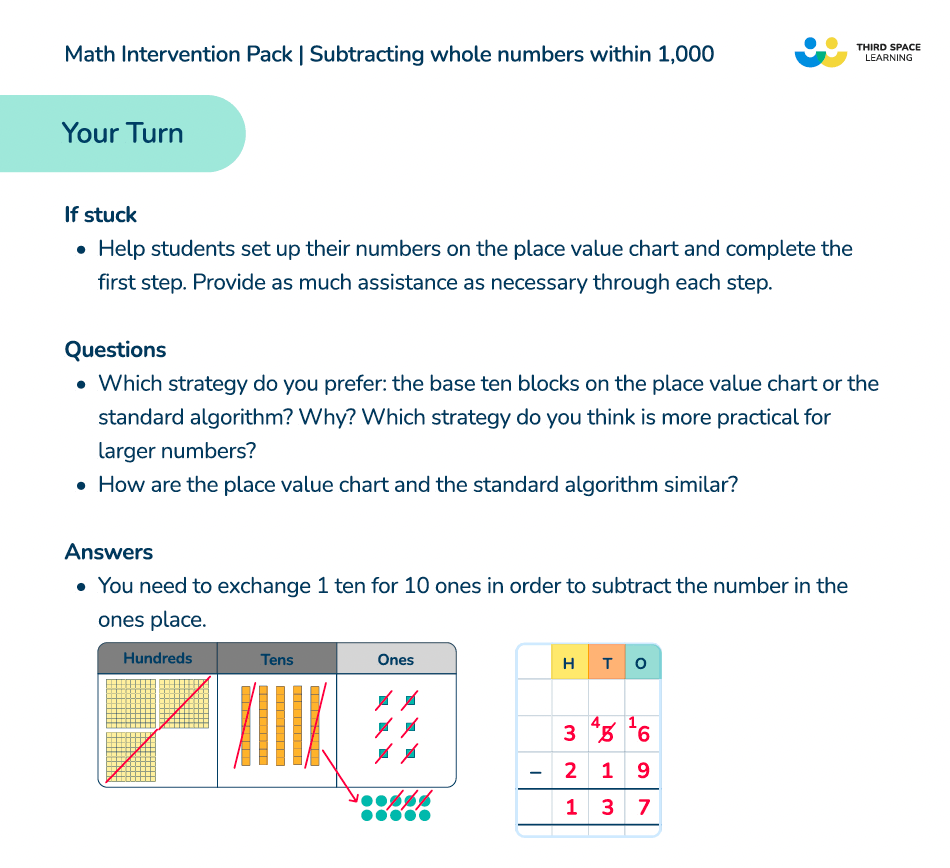
Rote memorization
Memorization or rote learning helps to teach vocabulary, basic facts, and information that does not change over time, for example, times tables.
Rote memorization strategies, like mnemonics or flashcards, are effective ways to build students’ long-term memory. The goal is not that students are full of facts, but that they are building background knowledge that they can use for higher order thinking and problem solving.
Demonstration
Modeling or demonstration is a direct instruction technique that involves the teacher showing students the process to help them visualize and better understand the required process.
For example, a teacher thinks aloud while solving a multi-step word problem, demonstrating each step in the process so that students can understand and apply the steps of the process on their own.
All Third Space Learning math tutoring sessions follow a “Follow me, Your Turn, You Do” structure. The “Follow me” section of the lesson allows AI tutor Skye to demonstrate the math concept and show students how to solve problems that use this math concept. Students then try independently using Skye’s demonstration to help them with their process.
2. Indirect instruction
While direct instruction is teacher-centered, indirect instruction is student-centered learning. In this approach, students observe, investigate, draw inferences, and are generally in charge of their learning. Teachers are the facilitators or guides of learning, rather than the leaders.
This teaching strategy often involves students working in small groups and learning from each other. Students are expected to make connections to content, solve problems, and engage in critical thinking while working on a common project.
Every Third Space Learning tutoring session begins with indirect instruction to assess how well the student understands the Lesson Objective(s). All sessions begin with a skill check in question that students complete independently. Based on the students’ process and answers, Skye assesses whether they are ready for independent practice or whether they need to walk through the lesson step by step.
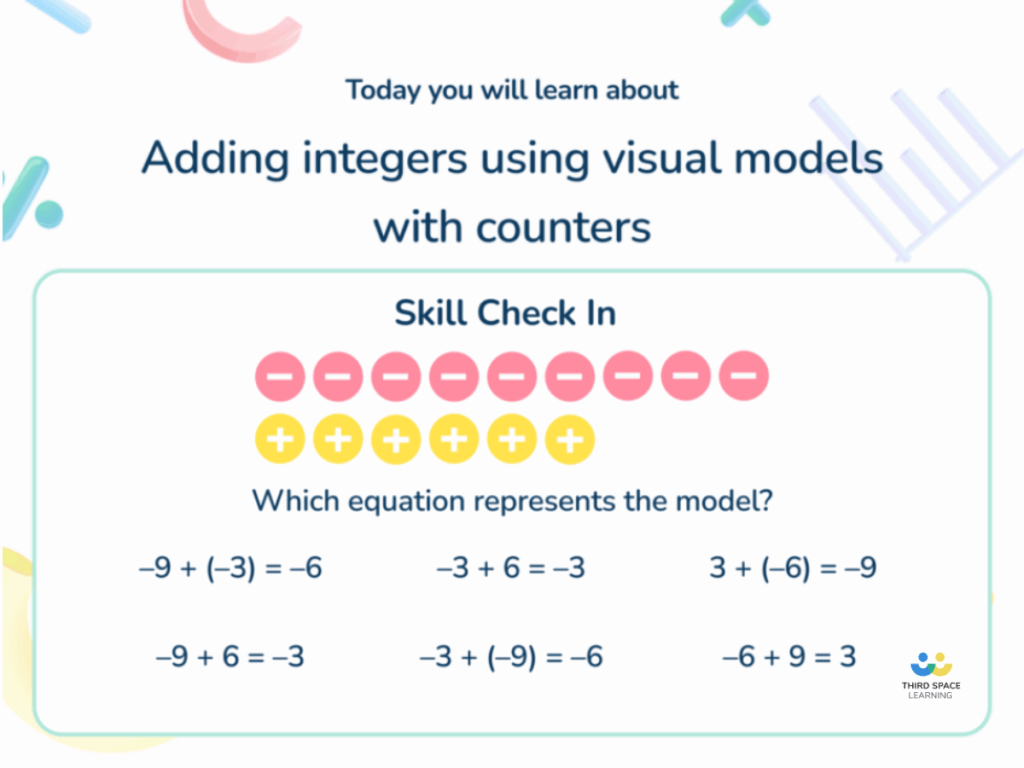
Concept mapping
A concept map, or brainstorming, is a diagram or visual representation that shows the relationships between concepts or ideas. The maps use circles and lines to record and connect ideas to what they already know.

Jigsaw
When using the jigsaw instructional strategy, the teacher divides students into small groups and each group completes part of an activity.
For example, each group may have one problem using sin, tangent, and cosine. They’re asked to solve it and then present their solution to the class.
The idea is that each student gains practice in one aspect of the skill, and learns about the other aspects from their peers.

Problem solving
Problem solving requires students to apply what they have learned to solve a problem. For example, in a math class, students must figure out how to fit a new piece of playground equipment onto the existing playground. As they solve the problem, need to apply their understanding of area, perimeter, and operations.
All Third Space Learning one-on-one math tutoring sessions contain a “Go further” question. This question is based on the same math skill or concept as the lesson but students must use what they learned during the session to solve the problem independently.
Project based learning
Project based learning encourages students to investigate and respond to a real-world challenge. The best project based learning tasks are authentic and engage students in complex thinking. Students can complete projects independently or in small groups.
For example, the class has an end-of-year party with a budget for food, drink, entertainment and decorations. The class must work out what they can buy for the class party with the budget provided.
3. Interactive instruction
Students are social, and interactive instruction takes that into account. Using interactive instruction such as computers or apps increases student engagement. Consequently, increasing how much students learn.
Third Space Learning’s tutoring sessions take place in an interactive classroom. Skye and students log on to the same interactive classroom and use interactive math tools to demonstrate math skills while communicating verbally over headsets.
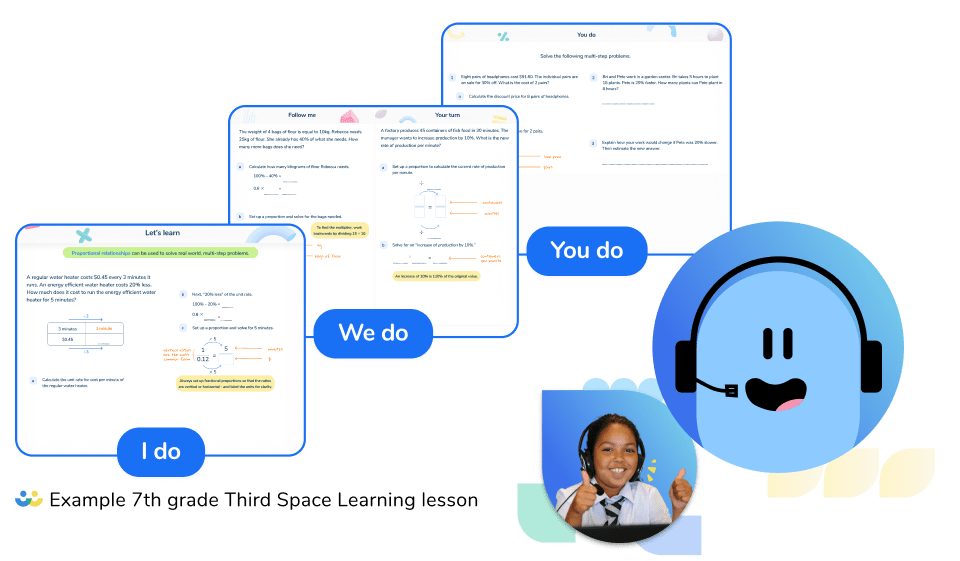
Think-pair-share
Small group discussions such as think-pair-share are a common instructional strategy.
For example, a teacher posts a word problem on the board. They tell students to think about how they would solve the problem, specifically, what steps would they take. After a minute, students share their ideas with each other. And, at the end, a few students share with the whole class.

Group Discussion
Group discussion is good to engage students in talking and thinking about more abstract ideas.
For example, a high school class might debate the question: What is math? Whole group discussion allows students to develop their thinking, summarize how their thinking has changed, and construct new knowledge.
4. Experiential learning
In short, experiential learning is learning by doing. This instructional strategy uses hands-on activities to engage students in applying what they have learned to real-world scenarios.
While experiential learning activities seem inherently fun, students must have a firm grasp of foundational knowledge to get the most out of them.
For example, in a middle grade math class, students may take on the real-world problem of figuring out how to set up and manage a class store. The students must apply math skills related to money, operations, and percentages to accurately calculate prices.
Gamification
Gamification is a new instructional strategy that teachers can use to enage students. This strategy uses game design, simulations and rewards, like badges, points, or leaderboards, to encourage participation and learning. The idea is to make learning more fun for students by applying techniques that video game designers use.
Role play
Students apply what they learned by acting out or using role play. In a younger-grade elementary classroom, students may create mock stores. For example, when learning about money, a teacher may instruct students to create a story where they must sell an item to another student. This helps the teacher assess students’ understanding of money, addition and subtraction.
5. Independent study
During independent study, students work to embed knowledge and reflect on what they know and where they have knowledge gaps.
Independent study is engaging for students, especially when working on a project that is of personal relevance to them.
For example, a teacher may have a student choose a research question and decide how to collect the relevant data. Then, the student collects and analyzes the data, learning about data collection and analysis through a topic that is relevant to them.
Students may create a survey about the types of food their peers want to have in the cafeteria. After students collect the data, they use graphing to organize and analyze the results. They can also collect information about the participants and calculate the mean, median, mode, and range of quantitative data to provide a full picture of the information they collected.
Professional development of instructional strategies for educators
Teachers’ use of instructional strategies constantly develops and changes over time. School leaders should ensure that professional development supports teachers by providing examples of how each instructional strategy is used across subject areas or grade levels. It can be helpful for teachers to learn these using the same strategies they will use for their students.
Some ways that school leaders can engage teachers in learning about instructional strategies include:
- Workshops
- Collaborative learning
- Action research
1. Workshops
Workshops and seminars help teach teachers new methods or provide new information. Providing teachers with information and allowing them to apply it in the workshop and in their classrooms is an effective way for them to learn or refine strategies.
2. Collaborative learning
Professional Learning Communities are a form of collaborative learning where teachers share ideas with peers. These are helpful when teachers have a basic understanding and can learn through discussion with their peers.
3. Action research
Experimentation and research encourage teachers to choose a strategy, apply it, collect data around the strategy, and reflect on the result. Teachers can talk through their process and reflections with their peers or an instructional coach.
Just like students, teachers may require differing levels of support. School leaders can plan differentiated training for teachers in ways that model the same practices we want teachers to use in the classroom.
Implementing instructional strategies
Teachers must use a range of Instructional strategies to engage students in learning and address individual student needs. Instructional strategies depend on students’ starting point, the lessons’ objectives, and what experiences students need to master the content.
During the creation of lesson plans, teachers should always carefully consider and choose instructional strategies that align with their classroom needs and support student learning.
School leaders must continue to plan professional development to support teachers’ understanding and use of ever-evolving instructional strategies to not only support teachers but students too.
Instructional strategies FAQs
What are examples of instructional strategies?
Some common examples include direct instruction, where teachers lead with lectures or demonstrations. Inquiry-based learning encourages students to ask questions and explore. Cooperative learning, where students work in small groups to tackle problems together.
What is an effective instructional strategy?
An effective instructional strategy is one that aligns with the students’ needs and learning goals while creating engagement and understanding. For example, inquiry-based learning can be highly effective because it encourages critical thinking and problem-solving, allowing students to explore topics deeply.
Which is the best teaching strategy to use in the classroom?
There is no single “best” teaching strategy for every situation. The most effective math strategy often depends on the subject, student needs, and learning goals. A blend of approaches often works well to keep students engaged and address different learning styles.
Do you have students who need extra support in math?
Skye—our AI math tutor built by experienced teachers—provides students with personalized one-on-one, spoken instruction that helps them master concepts, close skill gaps, and gain confidence.
Since 2013, we’ve delivered over 2 million hours of math lessons to more than 170,000 students, guiding them toward higher math achievement.
Discover how our AI math tutoring can boost student success, or see how our math programs can support your school’s goals:
– 3rd grade tutoring
– 4th grade tutoring
– 5th grade tutoring
– 6th grade tutoring
– 7th grade tutoring
– 8th grade tutoring
